Latest Posts by epic-flight - Page 6

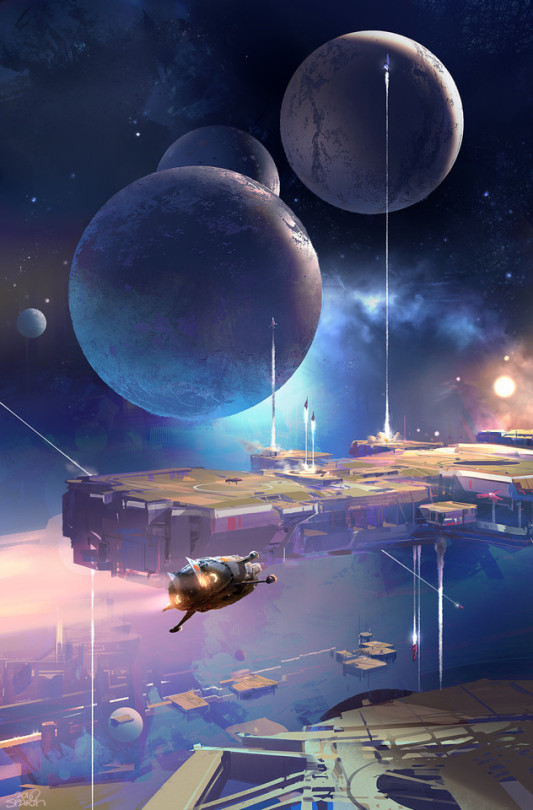
and now there’s TWO John Scalzi covers. https://gumroad.com/sparth

U.S. Navy Douglas A-1 Skyraider by Luccio Perinotto.

Godspeed and blue skies, General Yeager art by Romain Hugault
This impressive storm captured by Geoff Green over West Australia in August 2018, gives you an idea of the huge frequency at which lightning happen in an extreme weather event
Instagram: wonders_of_the_cosmos

Aggressive globe. Wonderful World. 1959.
Internet Archive
The amazing final seconds of yesterday’s Starship landing. @spacex https://www.instagram.com/p/CInrXfSniww/?igshid=1b5o8ndalzcq9


RAF Light Strategic Bomber Ca. 1971 by Rasmus Poulsen








Artworks by Lucio Perinotto
1936-1945 | Boeing B-17 Flying Fortress
1953-1959 | North American F-100 Super Sabre
1936-1942 | Latécoère Laté 298
1941-1945 | Hawker Typhoon
1934-1936 | Caudron C.460 Racer
1938-1948 | Supermarine Spitfire
1936-1945 | Boeing B-17 Flying Fortress


signal space

N1 Rocket - Mac Rebisz
Chaos theory, the principles underpinning certain nonlinear equations, also requires us to adopt a probabilistic description of many natural phenomena. The sizes and orbital positions of the planets in our solar system, for example, depend sensitively on the starting condition for solar system formation. If we ran the creation experiment again with slightly different parameters, we would get a different collection of planets with different orbital characteristics. But the results are not purely random. If we produced thousands of solar systems, again with similar but not exactly the same starting conditions, we would obtain a well-defined distribution of planet properties and planetary orbits. Although we cannot make exact predictions for any particular experiment, in principle we can determine the odds of getting any one type of planet or solar system. This intricate interplay between chance and determinism occurs throughout our physical universe and can even be applied to the consideration of how, and in what form, life can evolve.
Fred Adams, ‘Origins Of Existence: How Life Emerged In The Universe’ (2002)

(via sagansense)

Harrower-class Sith Dreadnought - Ansel Hsiao

Art G.Shvecova (Design graphics - Green Planet_250418)

Welcome planet Mercury in a 1970 illustration by David A. Hardy for Vision of Tomorrow. (AstroArt)

SSTO Orbital Lander
Movie: Interstellar UI Design: Double Negative
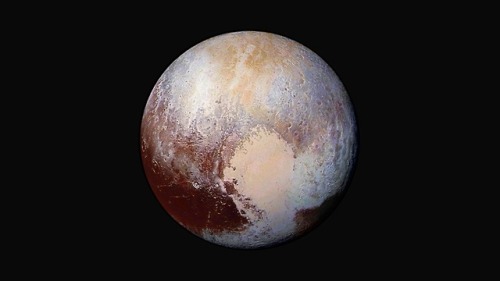

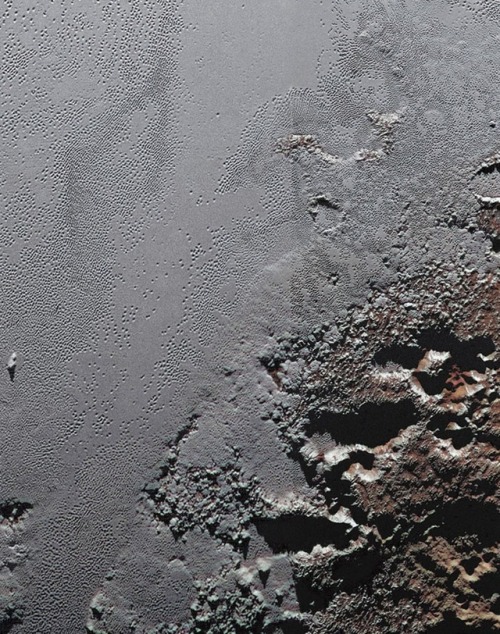
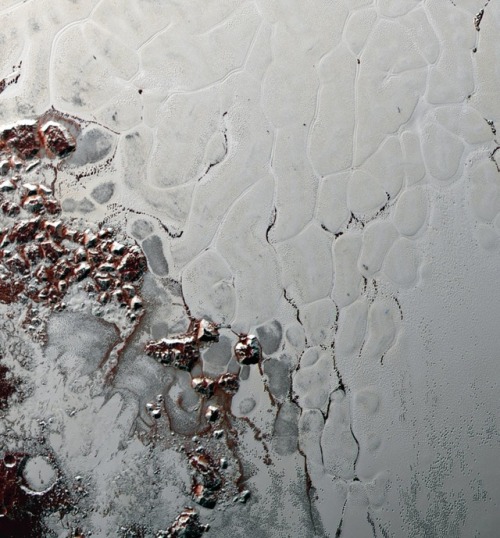
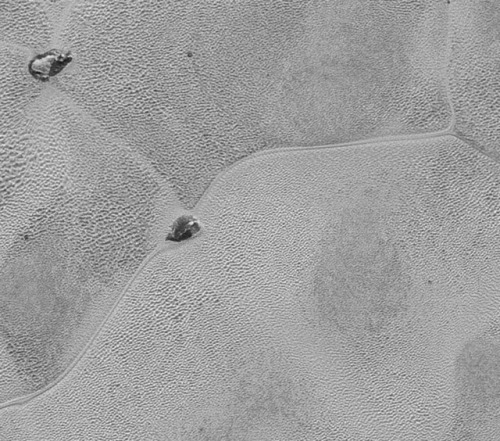
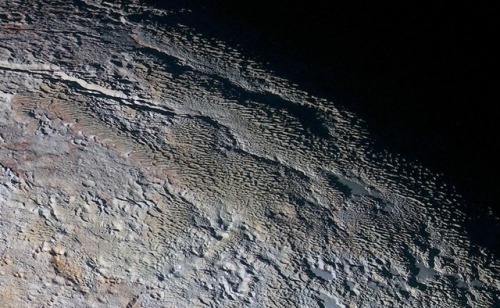
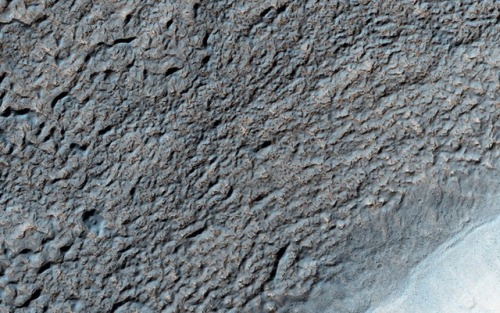
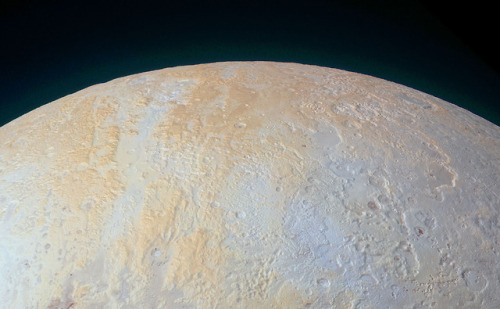
High-resolution images of Pluto taken by NASA’s New Horizons spacecraft.
The plains on Pluto’s surface are composed of more than 98 percent nitrogen ice, with traces of methane and carbon monoxide. Nitrogen and carbon monoxide are most abundant on the anti-Charon face of Pluto (around 180° longitude, where Tombaugh Regio’s western lobe, Sputnik Planitia, is located), whereas methane is most abundant near 300° east. The mountains are made of water ice. Pluto’s surface is quite varied, with large differences in both brightness and color. Pluto is one of the most contrastive bodies in the Solar System, with as much contrast as Saturn’s moon Iapetus. The color varies from charcoal black, to dark orange and white. Pluto’s color is more similar to that of Io with slightly more orange and significantly less red than Mars. Notable geographical features include Tombaugh Regio, or the “Heart” (a large bright area on the side opposite Charon), Cthulhu Macula, or the “Whale” (a large dark area on the trailing hemisphere), and the “Brass Knuckles” (a series of equatorial dark areas on the leading hemisphere). Sputnik Planitia, the western lobe of the “Heart”, is a 1,000 km-wide basin of frozen nitrogen and carbon monoxide ices, divided into polygonal cells, which are interpreted as convection cells that carry floating blocks of water ice crust and sublimation pits towards their margins; there are obvious signs of glacial flows both into and out of the basin. It has no craters that were visible to New Horizons, indicating that its surface is less than 10 million years old.
source | images: NASA/JPL
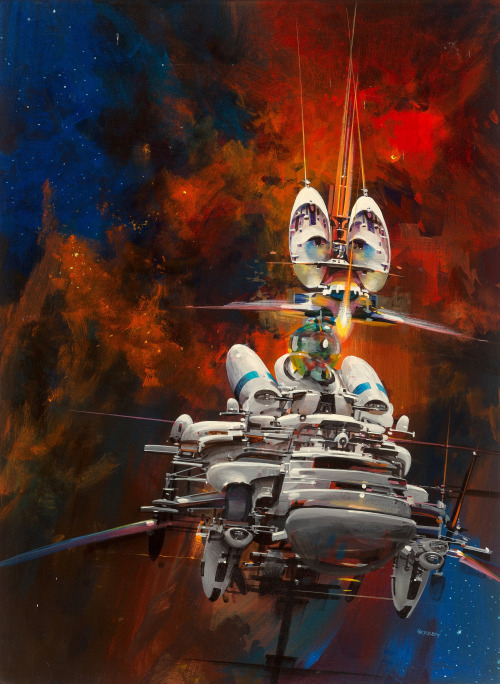
JOHN BERKEY Unknown Casein/Acrylic

F-16 Fighting Falcon Photo by © Rastislav Margus, FlyArt Publishing - www.FlyArt.biz

Produced by LEMAT WORKS
✨ Bonbon1 2 3 4 / Twinkle night / Snow / Golden Stars / instagram✨

SPARTH Collapsing Empire - Preliminary Sketch Digital

me irl

Dunes on the floor of the Endurance Crater on Mars, November 16, 2004.
(Planetary Society)

book cover. 2017
Boo-tiful Ring Galaxies

A ghoulish secret lurks within each of these gorgeous galaxies. Their rings are dotted with stellar graveyards!

These objects are called ring galaxies, and scientists think most of them form in monster-sized crashes. Not just any galaxy collision will do the trick, though. To produce the treat of a ring, a smaller galaxy needs to ram through the center of a larger galaxy at just the perfect angle.

The collision causes ripples that disturb both galaxies. The gravitational shock causes dust, gas, and stars in the larger galaxy’s disk to rush outward. As this ring of material plows out from the galaxy’s center, gas clouds collide and trigger the birth of new stars.

In visible light, the blue areas in the galaxies’ rings show us where young, hot stars are growing up. Faint, pink regions around the ring mark stellar nurseries where even younger stars set hydrogen gas aglow.
The newborn stars come in a mix of sizes, from smaller ones like our Sun all the way up to huge stars with tens of times the Sun’s mass. And those massive stars live large!
While a star like our Sun will last many billions of years before running out of fuel, larger stars burn much brighter and faster. After just a few million years, the largest stars explode as supernovae. When massive stars die, they leave behind a stellar corpse, either a neutron star or black hole.

When we turn our X-ray telescopes to these ring galaxies, we see telltale signs of stellar remnants dotted throughout their ghostly circles. The purple dots in the X-ray image above are neutron stars or black holes that are siphoning off gas from a companion star, like a vampire. The gas reinvigorates stellar corpses, which heat up and emit X-rays. These gas-thirsty remains are beacons lighting the way to stellar graveyards.
Spiral galaxies — like our home galaxy, the Milky Way — have curved arms that appear to sweep out around a bright center. The dust and gas in those spiral arms press together, causing cycles of star formation that result in a more even mix of new stars and stellar corpses scattered throughout our galaxy. No creepy ring of stellar corpses here!
To visit some other eerie places in the universe, check out the latest additions to the Galaxy of Horrors poster series and follow NASA Universe on Twitter and Facebook for news about black holes, neutron stars, galaxies, and all the amazing objects outside our solar system.
Make sure to follow us on Tumblr for your regular dose of space: http://nasa.tumblr.com






